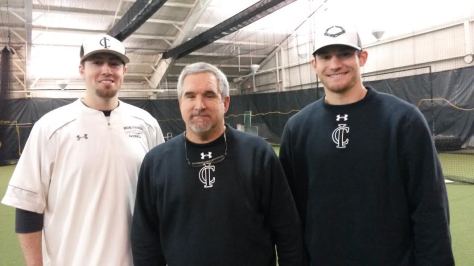
By STEVE KRAH
Scott Haase is a collector of baseball knowledge — especially about pitching.
Haase (rhymes with classy) was in Nashville, Tenn., at the 2020 American Baseball Coaches Association convention, talking face-to-face with folks he has connected with online or by phone.
“I learned pretty quickly what I was going to get most out of (the ABCA convention) was the networking,” says Haase, a board member, pitching coordinator and social media manager for the Indiana Twins travel organization. “It’s good to put a name to a face, chat in-person and strength that relationship.”
Among those he has connected with is Steve Merriman, a pitching coordinator in the Colorado Rockies system who also happens to share a hometown with Haase — Mt. Pleasant, Mich.
Haase, who turned 33 in December, has many certifications, including from OnBase U (functional movement) and Driveline Baseball as well as group exercise and personal training for his full-time job as health coach and wellness coordinator for Community Health Network. He was at Pitch-A-Palooza in Franklin, Tenn., Dec. 13-15, 2019.
For six years, he was pitching coach at Franklin (Ind.) Community High School — first for head coach Paul Strack and then Ryan Feyerabend. During that time, Twins president and founder and lead hitting instructor Jason Clymore reached out and Haase came to a clinic with Ron Wolforth of the Texas Baseball Ranch hosted by the Twins.
Haase came on board as an instructor and 17U pitching coach for Twins while also coaching at Franklin Community and conducting private lessons.
“It was six days a week of baseball for the first year of marriage,” says Haase, noting that his wife (Lora) was also busy at that time with coaching volleyball. “It was fun.”
After that first summer as a Twins coach, Haase decided to focus on being an instructor. He now coordinates pitching, teaches other instructors and coaches and runs the off-season training program with the organization as well as help Clymore with operations.
The Indiana Twins were housed in a facility near the University of Indianapolis then moved to spot in Martinsville with two buildings and three diamonds. There’s about 180 players in the program from 8U through 17U.
Haase notes that 8U gives family an introduction.
“Travel baseball is not right for everybody,” says Haase.
While high schoolers typically play up to eight tournaments each summer in June and July, younger players take part in up to 10 from April to July.
Beginning with 9U, teams have an off-season training program included in fees that lasts up to 20 weeks. Besides training in pitching, hitting, fielding and catching, there is Baseball I.Q.
Coaches were complaining because they were losing games because players who might look good during workouts don’t know how to back up first base or execute bunt coverage.
“Things that a travel ball coach doesn’t have as much practice time to cover,” says Haase.
A game created by Clymore involves a wipe board with a baseball field.
Players pull a card that gives them a situation. It might be “runner of first base and two outs.”
Another card is pulled.
It may say, “you’re the batter and you hit a ball past the defender in left-center field, what are you doing?”
That gives an opportunity to go around the room and see how many scenarios players identify.
As the game progresses, the card may have them as the right fielder and they are asked what they do when the ball goes into left-center field.
“It’s been pretty cool,” says Haase. “It gets them to think through it.”
Clymore is a proponent of mental skills and each team must spend part of their practices, which begin in January, doing some kind of mental work.
“It can be simple or elaborate,” says Haase. “They may watch a 10-minute video and have discussion and work sheet.”
It might be a TED talk or a motivational clip from a movie. Players and coaches will talk about how the subject elations to life, relationships, baseball or whatever.
“The mental component is such a big part of the game,” says Haase. “If you aren’t mentally strong, well-rounded an educated, in sports and in life you are not going to be able to succeed very much.
“If you don’t believe you’re going to have success — regardless of the reason — it’s going to be hard to have success.”
College players come back to train at the Twins facility during breaks. Among the recent alums is UIndy senior right-handed pitcher Reid Werner and Purdue Fort Wayne third baseman/pitcher Luke Miles.
Earlier in their development, the Schnell brothers (Nick and Aaron) and Avery Short played for the Indiana Twins. Outfielder Nick Schnell is now in the Tampa Bay Rays organization while left-hander Short is with the Arizona Diamondbacks.
A former left-handed pitcher/outfielder and team captain at Sacred Heart Academy in Mt. Pleasant (where he helped earn two district and regional titles and was the football team’s starting quarterback as a junior and senior), and pitcher at NCAA Division II Saginaw Valley State University in University Center, Mich., Haase video-taped himself and friends and studied footage of Tim Lincecum while trying to add velocity to his pitches.
Haase’s first coaching position was at a Little League in Saginaw.
He wound up in Indianapolis after long-distance dating his future wife. Scott and Lora Haase have an 8-month old (Max). Lora, who was an all-state volleyball player at Perry Meridian High School, coached Team Indiana in that sport for three years.

Scott Haase is a board member, pitching coordinator and social media manager for the Indiana Twins travel organization. The group has a training facility in Martinsville.

